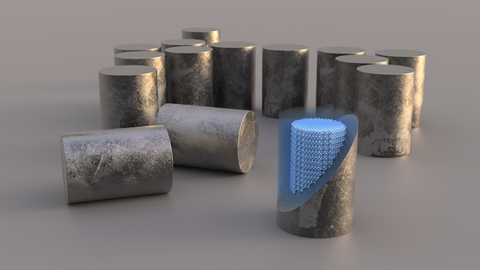Desktop Metal Announces Ultra Safe Nuclear Corporation Has Adopted the X-Series Line of Binder Jet 3D Printers to Deliver Advanced Nuclear Energy Solutions
Desktop Metal, Inc. (NYSE:DM), a global leader in additive manufacturing technologies for mass production, today announced that Ultra Safe Nuclear Corporation (USNC), a leading developer of Micro Modular Reactor (MMR®) systems for the production of safe, commercially competitive, clean and reliable nuclear energy, has adopted two 3D printers from the recently updated X-Series line of binder jetting systems, with two additional machines to follow this year.
 With Desktop Metal’s X-Series line of binder jet 3D printing systems, Ultra Safe Nuclear Corporation (USNC) is able to transform highly pure, crystalline, nuclear-grade silicon carbide (SiC) into the shapes and forms that can safely surround a nuclear fuel particle, enabling USNC’s Fully Ceramic Micro-encapsulated (FCM®) fuel innovation. (Photo: Business Wire)
With Desktop Metal’s X-Series line of binder jet 3D printing systems, Ultra Safe Nuclear Corporation (USNC) is able to transform highly pure, crystalline, nuclear-grade silicon carbide (SiC) into the shapes and forms that can safely surround a nuclear fuel particle, enabling USNC’s Fully Ceramic Micro-encapsulated (FCM®) fuel innovation. (Photo: Business Wire)
Desktop Metal’s recently rebranded X-Series line of binder jet 3D printing systems for metal and ceramic powders — which includes the InnoventX™, X25Pro™ and X160Pro™ — can 3D print advanced materials such as silicon carbide (SiC), a technical ceramic with extreme environmental stability often used in aerospace, armor, plasma shield, and high-temperature applications.
USNC transforms highly pure, crystalline, nuclear-grade SiC into the shapes and forms that can safely surround a nuclear fuel particle, enabling USNC’s Fully Ceramic Micro-encapsulated (FCM®) fuel innovation. The technology, which is detailed in a case study also released today, is a key component of USNC’s innovative fuel design for use in a new generation of advanced reactors.
“Binder jetting is a low-cost, high-yield, reliable process for our complex serial production,” said Dr. Kurt A. Terrani, executive vice president of USNC’s Core Division and an internationally recognized technology leader in nuclear fuels.
He previously led multiple research and development efforts at Oak Ridge National Laboratory. He added, “The advanced material capability of the X-Series machines is fundamental to our innovative approach to fuel design.”
The X-Series line was designed to scale applications from research and development to mass production with repeatable open parameters and performance across a range of machines. With the small-format InnoventX already installed at the company’s facility in Salt Lake City, Utah, USNC has developed its next-generation nuclear fuel matrix to be scaled up on the larger X25Pro and X160Pro systems.
“Driving mass adoption of additive manufacturing requires scalable systems capable of printing high-performance materials that enable the most innovative applications,” said Ric Fulop, Co-founder and CEO of Desktop Metal.
“We’re proud to support the mission of USNC with flexible binder jetting technology that takes customers all the way to production and helps play a role in solving global-scale problems with additive manufacturing solutions.”
The X-Series – Binder Jet 3D Printing for Metals and Ceramics
The X-Series family of scalable printers — the InnoventX, X25Pro and X160Pro — offers a differentiated approach to binder jetting enabled by patented Triple ACT, an advanced compaction technology for dispensing, spreading and compacting powders during the binder jet printing process. This flexible, open materials architecture is capable of binding together a wide range of powders and allows X-Series printers to process metals, ceramics and more with high density and repeatability for functional, precision parts and tooling in a wide range of build areas. Important for 3D printing silicon carbide, the whole process is carried out at low temperatures. This enables USNC to create complex and bespoke shapes in a material that is difficult or impossible to manufacture with traditional technologies or laser-based 3D printing methods.
To learn more about Desktop Metal and the X-Series, visit https://www.desktopmetal.com/products/xseries.
About Desktop Metal
Desktop Metal, Inc., based in Burlington, Massachusetts, is accelerating the transformation of manufacturing with an expansive portfolio of 3D printing solutions, from rapid prototyping to mass production. Founded in 2015 by leaders in advanced manufacturing, metallurgy, and robotics, the company is addressing the unmet challenges of speed, cost, and quality to make additive manufacturing an essential tool for engineers and manufacturers around the world. Desktop Metal was selected as one of the world’s 30 most promising Technology Pioneers by the World Economic Forum, named to MIT Technology Review’s list of 50 Smartest Companies, and the 2021 winner of Fast Company’s Innovation by Design Award in materials and Fast Company’s Next Big Things in Tech Award for sustainability. For more information, visit www.desktopmetal.com.
About Ultra Safe Nuclear Corporation
Ultra Safe Nuclear Corporation (USNC), a wholly U.S.-controlled corporation headquartered in Seattle, is a global leader in the deployment of micro reactors, and a strong vertical integrator of nuclear power technologies. The company is committed to bringing safe, commercially competitive, clean and reliable nuclear energy to power markets throughout the world. USNC is demonstrating MMR Energy Systems at the Canadian Nuclear Laboratories in partnership with Ontario Power Generation and at the University of Illinois and has started new projects to further deploy its technology in the United States, Canada, and Europe. The company adheres to strict inherent and intrinsic safety principles through technological innovation in fuels, materials and design: USNC is Reliable Energy. Anywhere.
This content was first published on the Desktop Metal website.

